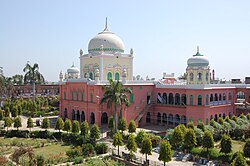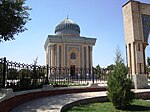Imdadullah Muhajir Makki
Sayyidut Taa’ifah Haji Imdadullah Muhajir Makki | |
|---|---|
| Personal life | |
| Born | 1814 |
| Died | 1899 (aged 81–82) |
| Religious life | |
| Religion | Islam |
| Denomination | Sunni |
| Jurisprudence | Hanafi [1] |
| Tariqa | Chishti |
| Muslim leader | |
| Part of a series on the |
| Deobandi movement |
|---|
 |
| Ideology and influences |
| Founders and key figures |
|
| Notable institutions |
| Centres (markaz) of Tablighi Jamaat |
| Associated organizations |
Imdadullah Muhajir Makki (1817 – 1899)[2]: 222 was an Indian Muslim Sufi scholar of the Chishti Sufi order.[2]: 223 [3] His disciples include Muhammad Qasim Nanautawi, Rashid Ahmad Gangohi, and Ashraf Ali Thanwi. In the Indian Rebellion of 1857, he led the Muslims in Thana Bhawan to fight against British.[4][5][6]
Early life
[edit]Imdadullah Muhaajir Makki was born in Nanauta, British India in 1817.[7]: 347 His father Muhammad Amīn named him Imdad Hussain. However, Shah Muhammad Ishaq gave him the name of Imdādullah.[7][8]
Aged seven, Imdādullah lost his mother who wrote her will that none shall touch her kid after her, and kept Imdādullah more beloved to her in those seven years; this became a hurdle that no one took care of Imdādullah's education.[7]: 348 He then started memorizing the Quran on his own but failed to do so. Aged 16, he traveled to Delhi with Mamluk Ali Nanautawi to seek education.[7]: 348
Religious work and travels
[edit]At the age of eighteen, his bay'at was accepted by Nasiruddin Naqshbandi.[8] Later he went to study under Mianji (Noor Mohammad Jhanjhanvi), as an initiate of the Chishti-Sabiri Sufi order, but after Mianji's death he temporarily became a semi-recluse. After wandering in the wilderness for six months he was overcome by a strong urge to travel to Medina. On 7 December 1845, he arrived at Banares. From there, he departed for Ottoman Arabia for Hajj and pilgrimage of the tomb of shrine of Muhammad.[8]
After the completion of his hajj, Imadadullah remained with Ishaq Muhajir Makki and others. Shah informed him that, after his pilgrimage to Medina, he should return to India. Sayyid Qudratullah Banarasi Makki sent several of his murids to accompany him to Medina.
Freedom struggle against the British
[edit]In Thana Bhawan, the local Sunnis declared Imdadullah their leader. In May 1857 the Battle of Shamli took place between the forces of Imdadullah and the British.[9]
Disciples
[edit]Disciples include:[7]: 352
- Maulana Peer Syed Shah Muhammad Meher Ali Quadri Qummaisi
- Ahmad Hasan Amrohi
- Asghar Hussain Deobandi[10]
- Ashraf Ali Thanwi[11]
- Muhammad Qasim Nanautawi
- Rashid Ahmad Gangohi
- Muhammad Anwaarullah Farooqui
- Muhammad Yaqub Nanautawi
- Mahmud Hasan Deobandi
- Maulana Badruddin Phulwarvi
- Sayyid Muhammad Abid[12]
- Najib Ali Choudhury[13]
Marriages
[edit]Imdadullah married for the first time at the age of 48. After the death of his first wife, he married a blind widow. Because she was blind, she could not manage all household work, so she requested him to take another wife so all household work. Imdadullah then married for the third time. None of his three wives bore him children.[citation needed]
Literary works
[edit]His books include:
- Faisla Haft Masala
- Kulliyat-e-Imdadiya
- Hashiya Mathnavi Moulana Rumi: This is an annotation in Persian on the Mathnawi-i Ma’nawi by Rumi. During Imadadullah's lifetime, only two parts could be printed. The remainder was printed after his death.
- Ghiza-e-Ruh (The Nourishment of the Soul): Imadadullah wrote this book in 1264 AH. Mianji Noor Mohammad Jhanjhanvi is also discussed. It consists of 1600 verses of poetry.
- Ikleelul Quran (Tafseer Quran in Arabi). First Published in Bahraich by Taj Offcet Press formerly Aqeel Press NazirPura Bahraich
- Jihad-e-Akbar (The Greater Jihad): He composed this book in 1268 AH. It is a poetic work in Persian that he translated it into Urdu. It consists of 17 pages with 679 verses.
- Mathnavi Tuhfatul Ushshaq (Mathnavi – A Gift for Lovers): This consists of 1324 poetic verses and was compiled in 1281 AH.
- Risala Dard Ghamnak (The Treatise of Painful Sorrow): It consists of 5 pages with 175 verses.
- Irshad-e-Murshid (The Directive of the Murshid): This book deals with wadha'if, muraaqabaat, aurad, and shajaraat of the four silsilas. It was written in 1293 AH.
- Zia ul Quloob (Glitter of the Hearts): This book is in Persian. He wrote this kitab in Makkah in 1282 AH on the request of Hafiz Muhammad Yusuf, the son of Hafiz Muhammad Zamin.
Death and legacy
[edit]Imdadullah died at Mecca in 1899.[9] He was buried in the Jannat al-Mu'alla cemetery besides the grave of Rahmatullah Kairanwi.[7]: 367 His biographical works include: Imdadul Mustaq Ila Asraful Akhlaq by Ashraf Ali Thanwi, [14] Shamaem Emdadiya by Muhammad Murtaza Khan Qanauji.[15]
See also
[edit]References
[edit]- ^ Makki, Imdadullah Muhajir (1999). Faisla Haft Masala. Muslim Kitabwi. p. 21.
- ^ a b Kugle, Scott Alan (2007). Sufis & saints' bodies: mysticism, corporeality, & sacred power in Islam. Chapel Hill: University of North Carolina Press. ISBN 978-0807872772.
- ^ Tareen, SherAli (2013). "FAYSALA-YI HAFT MAS'ALA (A RESOLUTION TO THE SEVEN CONTROVERSIES): Haji Imdadullah's Hermeneutics of Reconciliation". SAGAR: South Asia Graduate Research Journal. 21. hdl:2152/28002. Retrieved 7 November 2021.
- ^ Nizami, Moin Ahmad (2018), Kassam, Zayn R.; Greenberg, Yudit Kornberg; Bagli, Jehan (eds.), "Imdādullāh "Muhājir," Hājji", Islam, Judaism, and Zoroastrianism, Encyclopedia of Indian Religions, Dordrecht: Springer Netherlands, pp. 308–311, doi:10.1007/978-94-024-1267-3_2001, ISBN 978-94-024-1267-3, retrieved 15 October 2022
- ^ Rizvi, T. H. (1986). "Haji Imdadullah of Thana Bhawan : A Brief Survey of His Life and Work (18181899)". Proceedings of the Indian History Congress. 47: 489–494. ISSN 2249-1937. JSTOR 44141583.
- ^ Faruqi, Nisar Ahmad (1988–2016). "İMDÂDULLAH TEHÂNEVÎ". TDV Encyclopedia of Islam (44+2 vols.) (in Turkish). Istanbul: Turkiye Diyanet Foundation, Centre for Islamic Studies.
- ^ a b c d e f Deobandi, Nawaz (ed.). Sawaneh Ulama-e-Deoband (in Urdu). Vol. 1 (January 2000 ed.).
- ^ a b c "Biography of Hadhrat Haji Imdadullah Muhajir Makki r.a." Dedicated to Hadhrat Moulana Dr Hafez Tanveer Ahmed Khan Sahib Rahmatullahi Alayh. Retrieved 26 March 2017.
- ^ a b Asir Adrawi. Tazkirah Mashāhīr-e-Hind: Karwān-e-Rafta (in Urdu) (2 April 2016 ed.). Deoband: Darul Muallifeen. p. 44.
- ^ Abu Muhammad Maulana Sana'ullah Shujabadi. Ulama-e-Deoband Ke Aakhri Lamhaat (in Urdu) (2015 ed.). Maktaba Rasheediya Saharanpur. p. 51.
- ^ Rizwi, Syed Mehboob, History of the Dar al-Ulum Deoband, vol. 2nd, translated by Murtaz Hussain F Quraishi, p. 34
- ^ Rizwi, Syed Mehboob, History of the Dar al-Ulum Deoband, vol. 2nd, translated by Murtaz Hussain F Quraishi, p. 164
- ^ Thanwi, Ashraf Ali (1982). "Imdad al-Mushtaq ila Ashraf al-Akhlaq". Islamic Culture. LVI (I). Islamic Culture Board: 321.
- ^ Ahmad, Ishtiaque (2020). Ulama E Deoband Ki Swaneh Umriyon Ka Tanqeedi Tajziya Azadi Se Qabl (PhD thesis) (in Urdu). India: Department of Urdu, Maulana Azad National Urdu University. pp. 121–126. hdl:10603/338413.
- ^ Ahmad, Ishtiaque (2020). Ulama E Deoband Ki Swaneh Umriyon Ka Tanqeedi Tajziya Azadi Se Qabl (PhD thesis) (in Urdu). India: Department of Urdu, Maulana Azad National Urdu University. pp. 206–209. hdl:10603/338413.
Bibliography
[edit]- Kugle, Scott (2007). Body Revived The Heart of Ḥājji Imdādullah', Sufis & Saints' Bodies: Mysticism, Corporeality, and Sacred Power in Islam. Chapel Hill, NC: University of North Carolina Press. ISBN 9781469602684.
- Mawlāna Abd al-Rashīd Arshad. "Hadhrat Hāji Imdādullah Muhājir Makki". In Deobandi, Nawaz (ed.). Sawaneh Ulama-e-Deoband (in Urdu). Vol. 1 (January 2000 ed.). Deoband: Nawaz Publications. pp. 342–376.
- Tareen, SherAli (2013). "FAYSALA-YI HAFT MAS'ALA (A RESOLUTION TO THE SEVEN CONTROVERSIES): Haji Imdadullah's Hermeneutics of Reconciliation". SAGAR: South Asia Graduate Research Journal. 21. hdl:2152/28002. Retrieved 7 November 2021.

